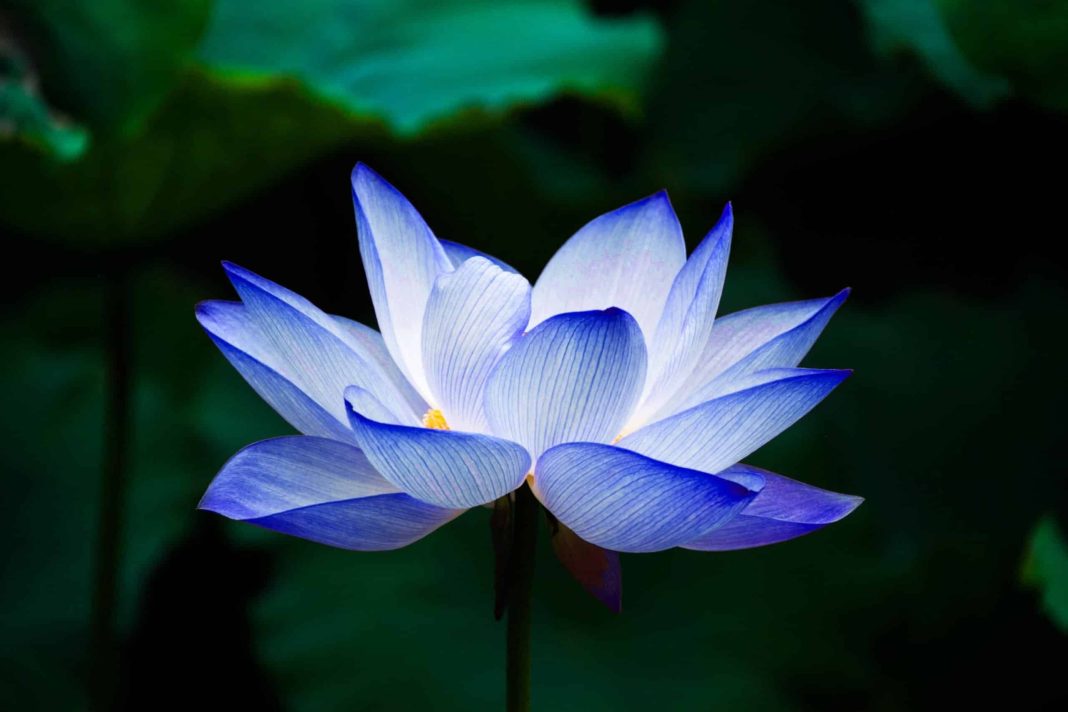Entheogenic plants are on the rise! And a new one to US consumers, blue lotus; is already getting attention from the US military.
What’s blue lotus?
Blue lotus, which goes by the official name of Nymphaea caerulea, is a type of water lily. For this reason, it’s also known as ‘blue water lily.’ It lives in fresh water environments, and is found often in East Africa, and Southern Arabia. It’s considered an ornamental plant, and has spread to different parts of the world through trade.
The plant has the ability to grow in mud that lacks both nutrients and oxygen; and has flowers that open in the morning, and close in the afternoon. The flowers can range from blue to white to mauve to pink. It should not be confused with its cousin plant, N. Lotus, which is known for its white flowers, or N. Mexicana which generally has yellow flowers. These are both found mainly in South Africa.
The plant was used through history, with many mentions from Ancient Egypt; where it shows up in writings like the Book of the Dead, and the Ebers Papyrus from 1,5000 BC. It’s thought the Turin Papyrus references it as well. These document its uses as a spiritual enhancer, as well as a medicine for tons of ailments. Egyptians considered it a symbol of life and immortality; and it was used to communicate with the divine; and to help navigate entrance into the afterlife. It’s associated with euphoria and at times hallucinations; and the flower shows up commonly in Egyptian art.
The main psychoactive compound is apomorphine, while other compounds are thought to contribute, like nuciferine. It’s been used historically as a medical agent for things like: sex drive enhancement, pain, depression, anxiety, insomnia, and upset stomachs. Apomorphine is associated with improvement in Alzheimer’s symptoms, as well as with erectile dysfunction.
It’s also associated with being an edible plant in South Africa, from which the rootstock was eaten by local communities. While this practice is said to date back to at least 1800, the logic answer is that it likely went on for hundreds, or even thousands of years, prior. Its said this is no longer a custom anymore. When it was eaten; this was done raw, or the plant was used to make curry.
Lotus flowers are aromatic, and were used to create perfume in ancient times. They are still used in aromatherapy today. It seems some amount of knowledge of the plant must have surfaced around 2009, as that year it was banned or restricted in Latvia, Poland, and Russia. Always an odd move when a plant has been around and used, for so much of history.
Blue lotus and the US military
These days, blue lotus is generally vaped. It’s not a scheduled drug in America, so its not illegal to possess or use; but its also not well known about yet, so there aren’t any well-known providers. It can be purchased in America in ‘smart shops,’ which specialize in the sale of psychedelics, entactogens, and other hallucinogens; but is more likely found in online marketplaces.
Blue lotus received attention in recent years due to several cases involving US soldiers. Although having said this, ‘several cases’ amounts to just a few cases, with no death involved. The cases were put together into a study, which came out in 2021. It is not specified why any of the involved, used the plant.
The study in question is called Toxicity From Blue Lotus (Nymphaea caerulea) After Ingestion or Inhalation: A Case Series. It consists of case material related to five military soldiers in active duty, who ended up in an emergency room due to altered mental states. Four of the soldiers had vaped a blue lotus product, while the last drank an infused drink.

All the soldiers presented with strange behavior, as well as a disturbance in general perception. Anxiety was also frequently seen. One soldier, age 27, was brought in by emergency medical services when his friends found him leaning against a wall, and staring into nothing. He reportedly had been found in this state, several times within the weeks prior. This soldier had ordered a vape liquid said to contain blue lotus through an internet site, but wouldn’t give much more information. Within a few hours, he was back to normal.
Another soldier, age 29, was brought in by emergency services for low responsiveness. This patient also reported vaping the substance. His family noted to EMS services that they believed he had been hallucinating, and had shown other strange behaviors. Like the first case, the symptoms resolved within hours. In fact, by the time EMS services arrived, he was already doing much better, and didn’t have to be held for more than four hours.
The third was a 22-year old soldier who was reported to have been engaging in bizarre behavior; which included sitting on a fence when he was found. The soldier reported drinking a wine that was infused with blue lotus flower; something he bought from eBay. Like the first two, his symptoms didn’t last long enough to be held past 2 hours, 45 minutes; and he was given no treatment.
The fourth example was a 19-year old soldier who came into the emergency room with chest pains. He reported that his pain began three hours prior to arrival, and that he had taken four hits from a vape, which he said was spiked. The vape came from the soldier’s friend, and there was an assumption it contained blue lotus. The pain went away quickly enough that he was released less than four hours after arrival. Like all the other cases, there was no confirmation of whether it was indeed blue lotus or not.
The last case was a 20-year old soldier who ended up in the emergency room because of bizarre behavior. He took a hit off a vape containing blue lotus, and proceeded with “thrashing his extremities;” I assume wildly enough for people to be concerned. He is the only one of the five to receive any actual treatment, which was simply fluids given intravenously. His vital signs returned to normal within three hours, and he requested to go, prior to a re-evaluation. A subsequent doctor’s visit showed metabolic normalcy.
The main takeaway points of this study
There are a few things to take out of this study, even though it was very small scale. The first is that blue lotus does not seem deadly. These are the only five cases spoken about related to the military. If there are more, they weren’t mentioned, which implies probably not. If these are indeed the worst case scenarios, then this study speaks to the general safety of the drug. These cases, perhaps, stand as examples of extreme scenarios; the kind that can happen with anything.

The next thing to understand, which is very important; is that blue lotus was not confirmed in any of these cases, and the products all (or nearly all) came from internet vendors. We could very well be looking at a study of five men, who all had issues unrelated to blue lotus, but who all thought they ingested it. Given that these came from internet purchases, and it doesn’t sound like any of the material was tested; we actually have no formal idea of what happened to these men. It’s quite possible they responded to additives, or that the products were not blue lotus at all.
This study makes clear two ting; how shady a lot of internet providers can be, and how important it is to understand dosing of a compound. It could be that all the products were what they were sold to be, and that the blue lotus did this. Or, it could be that none of the products were sold as what they were advertised to be. This might be less about blue lotus, and more about internet providers who want to make a buck. But it could also be that the men ingested far more than they should have.
Overall, assuming these were blue lotus cases, one of the biggest takeaways, is that its not terribly different from a THC overdose, or a bad trip on psychedelics. A person will feel very bad, and act in strange ways; but they’re also likely to settle back down within hours, and then be fine. In fact, this entire study does little to indicate this is a plant of concern to health and well-being; while its history shows it to be a useful medicine.
Conclusion
There doesn’t seem to be a reason for concern over blue lotus. This isn’t to say it can’t cause problems when taken in high amounts, when cut with additives, or when fake products are sold under its name. But there aren’t reports of death, and few of toxicity. Between these two factors, it presents, as yet, another useful plant (when used properly), which doesn’t deserve to have fear attached.
Welcome all! We appreciate you joining us at Cannadelics.com; your #1 choice for drug-related independent news focused on cannabis and hallucinogens. We provide regular updates so come around regularly; and sign up to our Cannadelics Weekly Newsletter; so you’re always on top of what’s going on.





